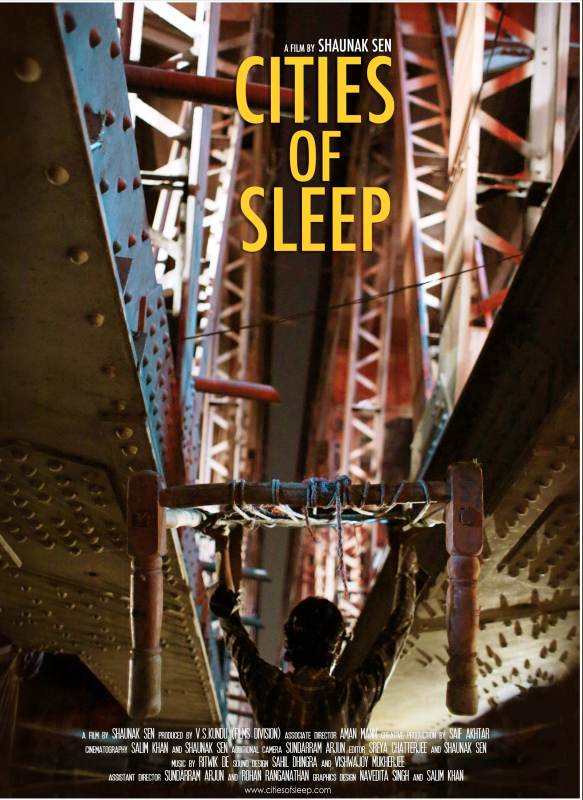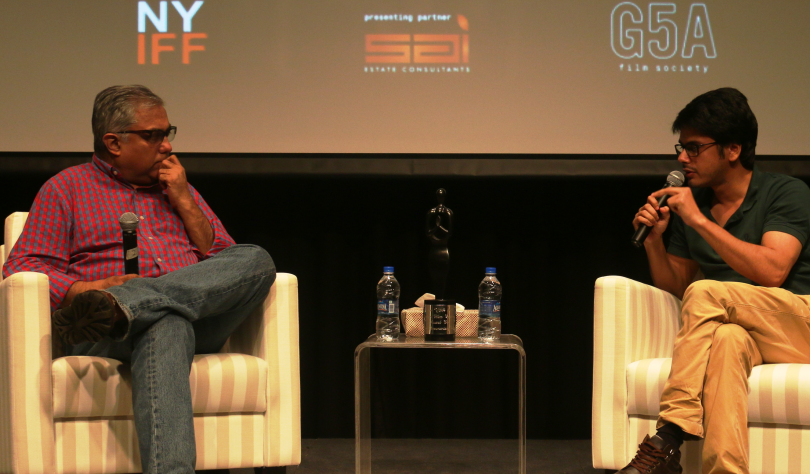
| Invitation |
| Press Release |
| Schedule |
| Reviews |
| filmfestivals.com |
| G5A-NYIFF screenings: Highway, Ek Selfie Aar Paar & Cities of Sleep |
 |
| G5A-NYIFF screenings: Highway, Ek Selfie Aar Paar & Cities of Sleep |
| If you’ve missed these two, you have missed a lot. While the former is fiction of the first order, treated in a documentary style, made by a trained and acclaimed young director the latter is a near feature-length documentary that explores a killer topic, and is enlivened by some remarkable central characters. G5A Film Festival is indeed lucky to have such impactful films to flag off its month-long screening programme of the Best of NYIFF (New York Indian Film Festival), the first of its kind in India, in progress at Foundation’s own, brand new and artfully designed premises, in central Mumbai. Highway was the inaugural film, on 21st June, while Cities was shown the next day. On both occasions, NYIFF Director Aseem Chhabra, in town for the event, held a Q and A with the directors. Chhabra regretted that budget constraints had prevented him from inviting Shaunak Sen, of Cities, to collect his Best Documentary award at NYIFF, in New York, a month ago, and took this opportunity to present it here. Highway-Ek Selfie Aar Paar: Intersections and introspections |
| The story of a routine Mumbai- Pune road journey--by cars, taxis, buses and trucks--that the 30-odd characters begin, in separate vehicles. They all come from different walks of life, carrying their own metaphorical, and literal baggage. Each one is in a hurry to reach their respective destination, which is apparently Pune, some four hours away, but also appears to be an occasion to come to terms with their lifetime choices. The journey, and a long traffic jam, brings into sharp focus some key questions that were hidden deep within--love/hate, ambition/principles, frustrations/hope--through interactions and mobile phone calls. Umesh Vinayak Kulkarni, the director, said in the Q&A that the idea germinated from his own multiple taxi journeys to and fro Mumbai, from native Pune, some years ago, when he was struggling to get producers for his projects, and Girish Kulkarni, who plays a lead role in the film, turned it into the script we saw. It is a mesmerising medley, but did not take final shape before Kulkarni had to undergo the painful exercise of pruning it down from four hours to 2 hours 17 mins. Using a single camera and working for the first time with a digital format (Umesh is a celluloid fan), he captures brilliant images and extracts wonderful performances from a hand-picked cast. Umesh Vinayak Kulkarni, the director, said in the Q&A that the idea germinated from his own multiple taxi journeys to and fro Mumbai, from native Pune, some years ago, when he was struggling to get producers for his projects, and Girish Kulkarni, who plays a lead role in the film, turned it into the script we saw. It is a mesmerising medley, but did not take final shape before Kulkarni had to undergo the painful exercise of pruning it down from four hours to 2 hours 17 mins. Using a single camera and working for the first time with a digital format (Umesh is a celluloid fan), he captures brilliant images and extracts wonderful performances from a hand-picked cast. Occasionally, the actors seem to abnormally grope for their opening words, perhaps one of the very, very few flaws in the film. There might be some debate about the misty portraits at the end, but there can be no debate about their execution. And what do you say about a maker, who spends about a month with tamasha performers, just to get the two women characters, out a 35–strong cast, right? Who procures 100-150 cars every night, some hired but most belonging to friends, parking them on the highway till morning every time, to shoot the epic jam scene, because he wanted it to look real? Just listen to the off-screen voice of the agent who sends the masseur to Tisca. He speaks barely five lines, all in chaste Urdu! Said Umesh, “I love the Urdu language, and even began to learn it some time ago, but like many other things in life, I left the study incomplete.” Mukta Barve, Sunil Barve, Kishore Chougule, Vidyadhar Joshi, Mayur Khandge, Vrishali Kulkarni, Purva Pawar and Shrikant Yadav are the other selfie stars. Rating: **** trailer: https://www.youtube.com/watch?v=ki-uU_syUY4 |
 |
| Cities of Sleep: Sleepless in Delhi or Cot and, sometimes wet, blanket |
| Why does former real-life insomniac Shaunak use the plural is not clear, for the film is just about Delhi, and a lot of it is set in Old Delhi. |
| The film looks at not only the tremendous social and political pressure that sleep exerts on the homeless in the city, but is also a philosophical exploration of sleep at large. A truly heady world of itinerant and long-term sleeper’s communities, as well as the infamous ‘sleep mafia’, exists in a city, where just securing a safe sleeping spot often becomes a question of life and death, for homeless men. Cities of Sleep trails the lives of two individuals, Shakeel and Ranjeet. Shakeel, a renegade, homeless sleeper has, for the last seven years, slept in a diverse range of improvised spots, like subways, (under) park benches, parking lots, abandoned cars and, lately, at areas controlled by the sleep mafia. It becomes a real ordeal just around the time the infamous winter rains of Delhi are due, and the unfortunate end up with wet blankets, literally. Ranjeet runs the ‘sleep-cinema’ community in Loha Pul, a huge double-storey bridge (trains above and vehicles below), straddling the banks of the river Yamuna. A thin strip of land, under Loha Pul (Iron Bridge), houses shanty cinemas, where over 400 odd homeless come and sleep through the day, for a nominal price, often while watching films. Shaunak Sen is a filmmaker, video artiste and scholar, based in Delhi. ‘Cities of Sleep’ is his first feature length documentary, funded by the Films Division of India. He has edited various other documentary and experimental fiction/non-fiction films, including ‘Squad’s Fall Guys’ (2013), ‘Old Town’ (2013) and ‘T&Lily’ (2014). He co-curated a live-event installation called Downtime, held simultaneously at Delhi and Berlin (at the Goethe Institute in New Delhi and Neukölln in Berlin), in November 2014. A mass communication graduate of AJK MCRC Jamia Milia, New Delhi, he is currently enrolled as a PhD student at the School of Arts and Aesthetics at the JawaharLal Nehru University in Delhi. His academic writing has been published in various journals including Bioscope and Widescreen. He has also worked as a journalist for Tehelka. This 74 minute documentary, partly pushed by paying its quixotic lead actor for his time (he is a beggar in real-life and his real name is Manoj, which he changed to Shakeel, just to blend with the community he spent so much time with), open our eyes to a reality that most Indians, and maybe other nationals, may not be aware of. We all know of hamams (community bath facilities), but the existence of cot and blanket (khaat and kambal, in Hindi/Urdu) units, located in unimaginable surroundings and run with a colluding mafia, albeit humane in its approach to the homeless, might come as a sort of revelation to many of us. As a sidelight, Manoj had a fleeting appearance in the Aamir Khan starrer, the hit feature Peekay, and became a star of sorts after that, also getting small parts in television soaps. He is from Bongaigaon on Assam, son of a Train Ticket Checker, who speaks fluent Urdu too. Sen succeeds in creating an aura about him by not showing his full face for about half the film, and, even afterwards, he avoids frontal close-ups. The opening scene sets the tone, Sen playing with visually with light, mist and a dog. Three others must be credited for this undeniably off-beat and compelling exercise: Salim Khan, the Cinematographer, has worked in many types of productions including documentaries (Sama, Dir. Shazia Khan) and feature length films (Listen Amaya, as Assistant Art director; for an urban Gujarati film, titled Fillam, Dir. Vishal Vada Vala, as Director of photography), as well as music videos, television and web commercials and corporate films. Sreya Chatterjee, the editor, completed her post-graduation from the Film and Television Institute of India (FTII), Pune, with specialisation in Film Editing. She collaborated on a feature length documentary project ‘Tales on Blindness’, which was a co-production between Portugal, Brazil and India. Aman Mann, Sen’s Associate Director, completed a stint in the corporate sector as a consultant at IMRB International, before joining the team of Cities of Sleep in 2013, initially in a research capacity, and then later as an associate director. |
 |
| At the post-screening Q &A, it became obvious that Sen is very serious about his thesis. Often like a confessional dissertation, and unnecessarily dense, he took the high road. But let’s stick to the film--it is not one that you will want to sleep out. Incidentally, what can be greater Sleeper surprise than a film about sleeping? |
| Rating: *** ½ |
| Trailer: https://youtu.be/rXzElV75x08 |
| G5A-NYIFF Film Festival resumes next week in Mumbai, at the Foundation's Black Box theatre, near Famous Mahalaxmi, close to the railway station. |
| 24.06.2016 | Siraj Syed's blog |
| Cat. : Independent |
| URL: http://www.filmfestivals.com/blog/siraj_syed/reviews_g5a_nyiff_ screenings_highway_ek_selfie_aar_paar_cities_of_sleep |